Positive Health Online
Your Country

Work and Leisure without Backache
listed in back pain, originally published in issue 51 - April 2000
In our industrialised societies, we have to handle and use many objects, tools and instruments – during work or leisure. At work there are, for example, the ubiquitous computer, and the chair, symbol of the westernised way of sitting. During leisure, the list is endless: tennis-rackets, golf-clubs, garden spades, bodybuilding machines, lawnmowers, and so on. Obviously, we use some of these objects for both leisure and work.
We devote much time to mastering the 'how-to' of these numerous things. Wisely, we understand, and don't object to, the need to learn how to handle them according to the operating instructions. Properly manufactured and correctly managed, our instruments and tools can last a long time without breaking down.
The same cannot be said about the owners and makers of these things. Man, as a psycho-physical instrument, breaks down with a surprising regularity and facility. Witness for example, back pain, which, as the clichéd expression has it, reaches epidemic proportions. It has been called 'the curse of the age' and is responsible for many days, sometimes months, of time off work. It's bad enough (or is it?) that backache can prevent us from going to work; that it can also spoil our leisure time is outrageous. Patients often complain about back pain triggered by gardening, playing golf, playing tennis, etc. When, because of a bad back, playing becomes a drag, something must be seriously wrong in the great scheme of life.
So, Man physically breaks down easily. Is it because the making of Man has been bodged? Did evolution, when it came to Man, lack good craftsmanship? Yet, "What a piece of work is a man!...the paragon of animals!" says an authority on human nature, a certain W Shakespeare. Could it be, then, that Man is misusing himself? It certainly is. Think about it: the very first instrument we ever use is ourselves. Even during rest and sleep we still use ourselves. 'Use' exercises a constant influence on our shape and function and yet we reckon without it.
We came into this world without any "User's Manual", and we have never consciously learned how to use ourselves. Nevertheless, guided by postural reflexes, most of us acquired a normal physical coordination during the first stages of life. Then, after these first years of development, we never give any thought to the way we use ourselves; we take it too much for granted. To use oneself unconsciously would be a blessing if we could rely on this being correct. Unfortunately, in our urban-industrialised life, we easily pick up bad habits of use. Past the age of three or five, most of us are very good at misusing ourselves, without knowing it.
We may be unaware of the way we use ourselves, but not of the effects it has on us: pain and disability. It is a pity, though, that we rarely link the effect with the cause. Misuse is the primary cause of backache, and it doesn't go away as long as we don't earnestly tackle this problem of use. The first prerequisite to work and play without backache is to master the way we use ourselves. How do we do that?
Before giving practical advice about the science and fine art of good use, let me warn you about some possible pitfalls. First, this article can only be an introduction to a vast and complex problem. Secondly, it cannot do justice to it as the solution requires the re-education of the kinaesthetic sense, which is the most important sense when it comes to using ourselves. At the onset we are facing a difficulty, as sensations cannot be taught by words. You cannot teach colours to a blind person, neither can you re-educate the kinaesthetic sense through writing. This being said, let's now discover this mysterious sense.
We have all learned at school that we have five senses: touch, smell, vision, taste and hearing. These senses deal with the perception of the outer world, hence they represent what is known as exteroception. But even five senses are not enough to cater for all our physiological needs. Besides the outer world, there is the inner world of our bodies, the perception of which is known as proprioception. Kinaesthesia deals with one part of this proprioceptive business. It enables us to be aware of the positions and movements of the different parts of our body. Kinaesthesia, not intuition, is our true sixth sense. Unfortunately, we are all, to some degree, kinaesthetically challenged.
Everybody has heard of optical illusion; very few of us have heard of kinaesthetic illusion. Yet, the latter is much more common and has much more serious effect in our lives than the former. When disordered, the kinaesthetic sense cheats us. We could lean to one side as much as the Tower of Pisa and yet feel as straight as the Eiffel Tower. To see for yourself how unreliable this sense is, do this little test. In a standing position, look at your feet and place them so that they are parallel. Now look ahead and register your sensations. If you belong to the majority of people who stand with their feet splayed out, you will now feel as if they were turned inward. This simple test is very revealing, at times shocking. It should convince us that we should not trust this sense, that we must re-educate it if we want to stand a chance in using ourselves correctly, and functioning efficiently and painlessly.
You have been warned: what you feel might not correspond to reality. To someone with an incorrect usage, what feels right is wrong and what feels wrong is right, kinaesthetically speaking. Now we can progress into more practical stuff. What we need is not so much to learn a 'catalogue' of so-called good postures but, rather, to unlearn our habits of bad usage. If you stop your bad postural habits, the right usage will be yours. A method to achieve this was developed, many years ago, by the late FM Alexander. He discovered empirically that the position of the head in relation to the neck and back conditions the coordination of the whole body. In misuse, the head is always pulled back and down, with shortened neck muscles. Whatever you are doing, the first corrective measure is, therefore, to become aware of the position of your head at all times, and then, to prevent it from wandering away from where it should be.
To give you an idea of what relative position the head should take, I invite you to do this little exercise. Lean back against a wall with your feet slightly away from it. Make sure the sacrum and the shoulder-blade area are touching the wall. Now try, slowly and gently, to touch the wall with the back of your skull. Don't force it! It might or might not be possible for you to do so. In any case, you will be now in a position where the head is back in relation to the neck (misuse), the latter being excessively arched (unless you are perfect). Now, keeping your skull in contact with the wall (for those who can reach it), tilt your head forward as if you were making a double chin, growing taller along the wall. This movement will elongate the muscles in the back of your neck down to the shoulder-blades area, and will erase the excessive neck arch. It will also make you aware of the extraordinary tightness of these muscles, shortened as they are by years of practising the bad habit of pulling the head back.
A good head poise will ensure a 'straight' and lengthened back, and toned abdominal muscles. However, we don't only have a head, neck and trunk, we also have limbs which affect them, and vice versa. Many activities require movements or positions where the knees and hips are flexed, such as sitting, bending forward, squatting and kneeling.
The act of sitting and the various positions between the start and the end of this action epitomize basic, fundamental movements and postures which are constantly used during our daily activities, both at work and at play. From Homo erectus to Homo sapiens, via Homo habilis, we have evolved into Homo sedens or seated Man.[1] The time spent in the sitting position is phenomenal. To know how to use yourself correctly while seated is therefore essential. Being aware of this problem, some manufacturers offer ergonomic chairs. I would not deny that some chairs are much better than others. But even the best and most expensive chairs will not teach you how to sit properly, and sitting wrongly in an ergonomic chair will harm you as much as sitting wrongly in a bad chair (see Figures 1 and 2).
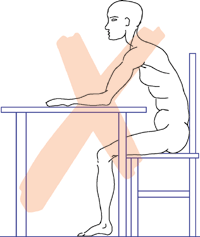
Figure 1 An example of bad usage in a sitting position. The head is back in relation to the neck, the lower back is rounded,
the pelvis is tilted backward, the whole back is shortened and the abdominal muscles are slackened
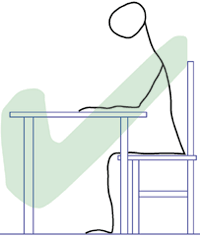
Figure 2 Good usage. The trunk is leaning forward from the hip joints allowing the natural curves of the spine to be respected. There is good poise of the head and lengthening of the spine. As long as the correct relative positions of the head/neck/back are kept, the trunk could be leaning forward more, or be vertical, or even leaning backward against the back of the chair without any problems
This brings us to the hip joint. Cursed with a blunt kinaesthetic sense, many of us do not know where our hips are; it is a very misunderstood joint. It is common to think them much higher than they actually are – to mistake the waist for the hips. This kinaesthetic delusion is putting your back at risk by favouring the creation of a pseudo hinge in the lower back. When sitting or bending forward incorrectly, the hips are insufficiently flexed, the lower back is bent and rounded, and the neck and upper back are arched. During such misuse, there is a conflict of forces: the hamstrings pull the iliac bones backward and downward; the back muscles pull the sacrum away from the iliac bones. It's not surprising that sacro-iliac symptoms abound. Moreover, the constant rounding of the lower back puts a strain on the discs which have to bear undue wear and possible tear (see Figures 3, 4, 5 and 6).
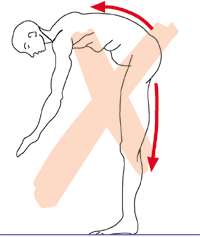
Figure 3 Bending forward the wrong way. The hips are not sufficiently flexed. As a result, the iliac bones are pulled backward and downward while the sacrum is pulled in an opposite direction by the trunk going forward. The head is pulled back, retracted into the shoulders. The abdominal muscles are inhibited, allowing the abdomen to sag
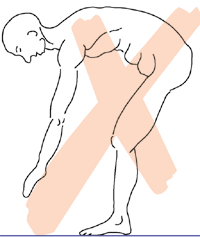
Figure 4 Bad usage of the bending position, although the knees are bent. The hips, knees and ankles are insufficiently flexed and the spine is bent in a shortened way. Same aspect of the trunk as figure 3
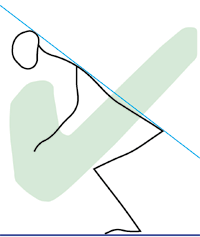
Figure 5 Good usage in the bending position. Good alignment of the head, upper back and pelvis on the same plane. Good flexion of the hips, knees and ankles
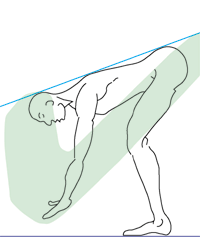
Figure 6 Same as above. The position of the head could be slightly improved by tilting it forward a bit more. Because of the correct alignment of the head/neck/back, the abdominal wall is flattened and toned
"Bend your knees." How many times have you heard this piece of advice? It's a fair one, but not as easy to put into practice as it sounds. It's easier said than done simply because of our numbed kinaesthesia, and because our calf muscles are usually too short for this job. A common form of misuse while sitting in a chair consists of bending too sparingly at the knees and hips, and in concertina-ing the spine. The person who sits in this manner starts well, by bending the knees. Then, it is as if he changes his mind and proceeds to push the buttocks backward in search of the chair. This action stops and reverts the bending of the knees. It also arches the lower back and neck. The major joints (hips, knees and ankles) end up 'rusty' through lack of use while the whole spine and its joints are misused.
Next time you have to bend your knees, be careful not to commit the following errors. Do send your knees forward, NOT the hips and pelvis. Don't spare your ankle joints; you have to coax them to flex. We usually bend the knees when we have to bend forward, to pick up or lift something. So, we are back with the hip joints. Assuming that your back is properly aligned – and it will be if you remember to direct your head forward and up – you must take great care NOT to change its shape while bending forward. In other words, bend from the hips, not from the lumbar spine. And never forget your head: do not pull it back.
The advice I have given here might seem too simple and trivial to be of any real value. The simplicity is only apparent. The good use and re-education of the kinaesthetic sense are slow processes, paved with pitfalls. To be successful, you'll have to constantly question your postures, movements and positions, until you bring yourself to your (kinaesthetic) senses. If you seriously and consistently follow this advice, its value will soon be revealed to you – back pain will stop harassing you. The proof is in the pudding. So, have your pudding, and eat it to find out.
References
1. Mandal AC. The Seated Man, Homo Sedens. Dafnia Publications. Denmark. 1985.
Comments:
-
No Article Comments available